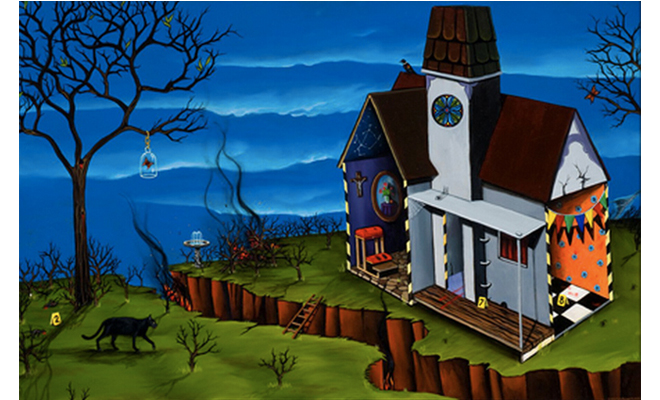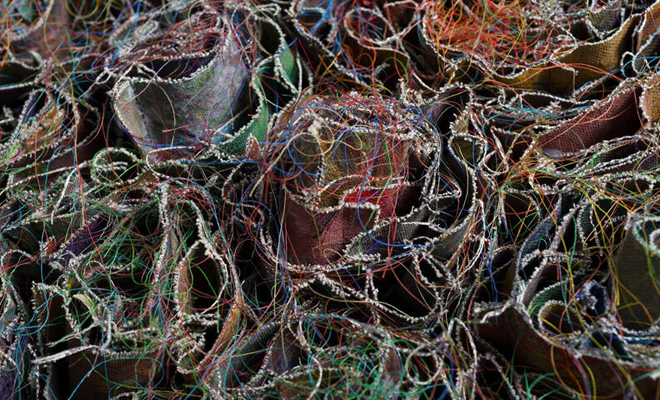Art Fly: Julia Street November Openings

Carolyn Zacharias McAdams, The Repentant, 2012. Oil on panel. Courtesy the artist and LeMieux Galleries, New Orleans.
Editor's Note
We’re trying something new (isn’t that why you love us?)! Introducing Rachel Gorman, Pelican Bomb’s art fly on the wall. She hits openings, lectures, and events and tells you what she’s seen and heard. You can still count on us for in-depth reviews, but Rachel will be here regularly dishing about what’s happening and where. So before you head to St. Claude this weekend, check out Rachel’s recap of last weekend on Julia Street.
A string of Julia Street galleries had openings last Saturday, and I, your intrepid arts reporter, was there to do some hard-hitting investigative journalism on what they unveiled, or maybe just score some free wine. Here’s what I uncovered.
LeMieux was the first gallery I stopped in. They were opening a show of new works by Alan Gerson, a Louisiana-based painter whose art, as he described it, focuses on “children, their world, and the world that we live in.” The major rooms were dedicated to paintings that clearly depict kids at play (works were titled things like Sack Race and Three Legged Race, for example) but the figures are rendered with such flat affectation that it seems highly unlikely they are just about having fun at a picnic. Gerson’s faces are painted in a cartoonish, vaguely skeletal way, with wide-set, beady eyes and Chiclet-toothed perma-smiles that sometimes literally stretch from ear to ear. His children are gripping but very strange. And judging by their pronounced under-eye circles, some of them are getting pretty tired of sack races. I decided to move on.
In the back of LeMieux, Carolyn McAdams, a self-identified “regional surrealist” who paints small-scale, highly detailed odes to rural Texas, motherhood, and as she put it “disappointment, struggle, and crime” also had her works displayed. These paintings are meant, as McAdams explained to me, to be nightmarish. Indeed they are—the sort of quietly and surreally sinister dreamscapes that Henri Rousseau might have made if he were into tinier canvases and painting a lot more fire. McAdams’ works are puzzling in their symbolism—you could get lost in her details for days—but I had other works to see and besides, there wasn’t a snack left in the building. I headed to the next space with Gerson’s children’s small eyes following me out the door.
I headed next to Jonathan Ferrara Gallery, a space that was in the midst of opening a new show called “Density” by Anita Cooke. One step inside and I thought, so this is where all those Gerson kids’ energy had gone. Cooke’s show was electric. The gallery crowd was dynamic and cheerful, and her large-scale copper, string, and canvas works feel imbued with the iridescent chaos of a really ambitious magpie’s nest. I spent an inordinate amount of time staring at Cooke’s Hidden Garden, 2011-2012, a work that operates like a mixed-media magic-eye puzzle for the highfalutin set. I probably would have stayed there all night, focusing and refocusing my eyes to conjure flowers out of their noisy and abstracted backgrounds, but I was jolted back to the present by another type of electricity that caught my attention: video!
The animated works by Dan Rule shown in the back room of Ferrara’s gallery had an energy entirely different from Cooke’s, and I don’t say that just because some of them were moving. Highly conceptual, Rule’s art explores ideas about historical and literal perspective through animation that compresses war, Mardi Gras, and a vaguely futuristic dystopia into an infinite, cyclical loop. Rule’s prints were also on display Saturday night; works that, as he explained, take the kind of visual problems inherent in traditional landscapes and, through hyper-colored collage, make them all the more glaring and bizarre. I would have loved to stay and continue to talk about being disoriented with Rule, but it was time to pursue the real deal: I had a free drink to find! It was on to the next opening.
The final show I visited Saturday night was at the Arthur Roger Gallery called “Against the Tide.” There, the prolific Jacqueline Bishop had filled the huge rooms with paintings, drawings, lithographs, and embroidery that thematically explore, as she put it, the “interconnectedness of humans and non-humans, globalization and landscape desecration.” The paintings were large and dark, depicting choppy water, fire, and twisted trees with birds and other animals stacked at their trunks or entangled in their limbs. The drawings and lithographs dealt with animal subjects as well, but these were differently handled, illustrated like 18th-century scientific studies on printed-paper clippings that Bishop told me she has collected from around the world. I found her embroidery to be the most beautiful and intriguing work of the show. Even after I realized that they belied a very serious message about the global politics of clothing manufacturing, it was refreshing to visit with her small-scale, sketchy birds sewn with colorful thread after what seemed like a night full of doom and gloom.

Anita Cooke, Hidden Garden (detail), 2011-2012. Acrylic on canvas, thread, bobby pins. Courtesy the artist and Jonathan Ferrara Gallery, New Orleans.
Editor's Note
So there it is, folks, your Saturday night Julia Street gallery opening recap. This reporter never did find that free wine, but a little art appreciation does the body good. Besides, there’s always next time...



